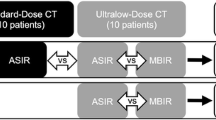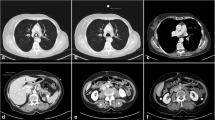Abstract
Objectives
To compare image quality and radiation dose between high-pitch mode (HPM) and low-pitch mode (LPM) CT in young children.
Materials and methods
Forty-seven children (mean age 35.6 months; range, 0–126 months) underwent 49 CT examinations in HPM or LPM and were divided into high or low respiratory rate (RR) groups. A qualitative image quality was compared between the two modes. The volume CT dose index (CTDIvol) and dose-length product (DLP) were evaluated from the dose reports, and effective doses were assessed using a paediatric phantom.
Results
Image quality was generally better for HPM than LPM (diagnostic acceptance score, 4.00 vs. 3.46, P = 0.004); the difference was more prominent in the high RR group (4.00 vs. 3.22, P = 0.001). However, there was no significant difference in the low RR group. The mean DLP value was higher in HPM than LPM (29.48 mGy · cm vs. 23.46 mGy · cm, P = 0.022), while CTDIvol was not significantly different. The total effective radiation dose was 26 % higher in HPM than LPM (1.82 mSv vs. 1.44 mSv).
Conclusions
LPM can be considered for paediatric lung evaluation in young children with low RRs to reduce radiation dose while maintaining favourable image quality.
Key Points
• Radiation exposure is higher on high-pitch “Flash spiral mode” than on low-pitch “X-CARE mode”.
• “Flash spiral mode” generally showed better image quality than “X-CARE mode”.
• Difference in image quality was more prominent in the high RR group.
• There was no difference in image quality in the low RR group.
• “X-CARE mode” should be considered in a limited population with low RRs.





Similar content being viewed by others
Abbreviations
- HPM:
-
high-pitch mode
- LPM:
-
low-pitch mode
- RR:
-
respiratory rate
- CTDIvol :
-
volume CT dose index
- DLP:
-
dose-length product
- HU:
-
Hounsfield unit
- SD:
-
standard deviation
- SNR:
-
signal-to-noise ratio
References
Bakhshi S, Radhakrishnan V, Sharma P et al (2012) Pediatric nonlymphoblastic non-Hodgkin lymphoma: baseline, interim, and posttreatment PET/CT versus contrast-enhanced CT for evaluation—a prospective study. Radiology 262:956–968
Furth C, Denecke T, Steffen I et al (2006) Correlative imaging strategies implementing CT, MRI, and PET for staging of childhood Hodgkin disease. J Pediatr Hematol Oncol 28:501–512
Tiddens HA (2006) Chest computed tomography scans should be considered as a routine investigation in cystic fibrosis. Paediatr Respir Rev 7:202–208
Shin S-M, Kim WS, Cheon J-E et al (2013) Bronchopulmonary dysplasia: new high resolution computed tomography scoring system and correlation between the high resolution computed tomography score and clinical severity. Korean J Radiol 14:350–360
Malviya S, Voepel-Lewis T, Eldevik O, Rockwell D, Wong J, Tait A (2000) Sedation and general anaesthesia in children undergoing MRI and CT: adverse events and outcomes. Br J Anaesth 84:743–748
Lell MM, May M, Deak P et al (2011) High-pitch spiral computed tomography: effect on image quality and radiation dose in pediatric chest computed tomography. Invest Radiol 46:116–123
Deak PD, Langner O, Lell M, Kalender WA (2009) Effects of adaptive section collimation on patient radiation dose in multisection spiral CT. Radiology 252:140–147
Mandiwanza T, Saidlear C, Caird J, Crimmins D (2013) The open fontanelle: a window to less radiation. Childs Nerv Syst 29:1177–1181
Duan X, Wang J, Christner JA, Leng S, Grant KL, McCollough CH (2011) Dose reduction to anterior surfaces with organ-based tube-current modulation: evaluation of performance in a phantom study. Am J Radiol 197:689–695
Ketelsen D, Buchgeister M, Fenchel M et al (2012) Automated computed tomography dose-saving algorithm to protect radiosensitive tissues: estimation of radiation exposure and image quality considerations. Invest Radiol 47:148–152
Angel E, Yaghmai N, Jude CM et al (2009) Dose to radiosensitive organs during routine chest CT: effects of tube current modulation. Am J Radiol 193:1340
Fleming S, Thompson M, Stevens R et al (2011) Normal ranges of heart rate and respiratory rate in children from birth to 18 years of age: a systematic review of observational studies. Lancet 377:1011–1018
van der Molen AJ, Geleijns J (2007) Overranging in multisection CT: quantification and relative contribution to dose–comparison of four 16-section CT scanners. Radiology 242:208–216
Valentin J (2007) The 2007 Recommendations of the International Commission on Radiological Protection: User’s Edition: International Commission on Radiological Protection
Cristy M (1981) Active bone marrow distribution as a function of age in humans. Phys Med Biol 26:389
Bastos MA, Lee EY, Strauss KJ, Zurakowski D, Tracy DA, Boiselle PM (2009) Motion artifact on high-resolution CT images of pediatric patients: comparison of volumetric and axial CT methods. Am J Radiol 193:1414–1418
Kelly D, Hasegawa I, Borders R, Hatabu H, Boiselle P (2004) High-resolution CT using MDCT: comparison of degree of motion artifact between volumetric and axial methods. Am J Radiol 182:757–759
Christensen JD, Seaman DM, Lungren MP, Hurwitz LM, Boll DT (2014) Assessment of vascular contrast and wall motion of the aortic root and ascending aorta on MDCT angiography: dual-source high-pitch vs non-gated single-source acquisition schemes. Eur Radiol 24:990–997
Morsbach F, Gordic S, Desbiolles L et al (2014) Performance of turbo high-pitch dual-source CT for coronary CT angiography: first ex vivo and patient experience. Eur Radiol 24:1889–1895
Baumueller S, Alkadhi H, Stolzmann P et al (2011) Computed tomography of the lung in the high-pitch mode: is breath holding still required? Invest Radiol 46:240–245
Bankier AA, O’Donnell CR, Boiselle PM (2008) Quality initiatives. Respiratory instructions for CT examinations of the lungs: a hands-on guide. Radiographics 28:919–931
Ritchie C, Godwin J, Crawford C, Stanford W, Anno H, Kim Y (1992) Minimum scan speeds for suppression of motion artifacts in CT. Radiology 185:37–42
Greess H, Wolf H, Baum U et al (2000) Dose reduction in computed tomography by attenuation-based on-line modulation of tube current: evaluation of six anatomical regions. Eur Radiol 10:391–394
Greess H, Nömayr A, Wolf H et al (2002) Dose reduction in CT examination of children by an attenuation-based on-line modulation of tube current (CARE Dose). Eur Radiol 12:1571–1576
Hara AK, Paden RG, Silva AC, Kujak JL, Lawder HJ, Pavlicek W (2009) Iterative reconstruction technique for reducing body radiation dose at CT: feasibility study. Am J Radiol 193:764–771
Lucaya J, Piqueras J, García-Peña P, Enríquez G, García-Macías M, Sotil J (2000) Low-dose high-resolution CT of the chest in children and young adults: dose, cooperation, artifact incidence, and image quality. Am J Radiol 175:985–992
Gordic S, Desbiolles L, Sedlmair M et al (2015) Optimizing radiation dose by using advanced modelled iterative reconstruction in high-pitch coronary CT angiography. Eur Radiol. doi:10.1007/s00330-015-3862-5
Acknowledgments
We thank Allison Alley for language consultation and editing.
The scientific guarantor of this publication is Young Hun Choi, Clinical Professor, Department of Radiology, Seoul National University Hospital. The authors of this manuscript declare no relationships with any companies, whose products or services may be related to the subject matter of the article. The authors state that this study has not received any funding. No complex statistical methods were necessary for this paper. Institutional review board approval was obtained. Written informed consent was waived by the institutional review board. No study subjects or cohorts have been previously reported. Methodology: Retrospective, Cross sectional study, Performed at one institution.
Author information
Authors and Affiliations
Corresponding author
Electronic supplementary material
Below is the link to the electronic supplementary material.
ESM 1
(DOCX 16 kb)
Rights and permissions
About this article
Cite this article
Kim, S.H., Choi, Y.H., Cho, HH. et al. Comparison of Image Quality and Radiation Dose between High-Pitch Mode and Low-Pitch Mode Spiral Chest CT in Small Uncooperative Children: The Effect of Respiratory Rate. Eur Radiol 26, 1149–1158 (2016). https://doi.org/10.1007/s00330-015-3930-x
Received:
Revised:
Accepted:
Published:
Issue Date:
DOI: https://doi.org/10.1007/s00330-015-3930-x




